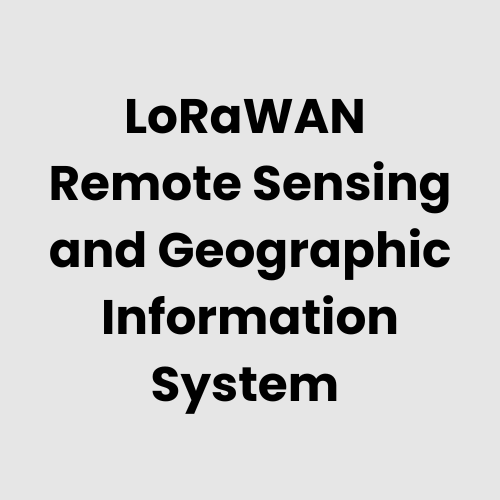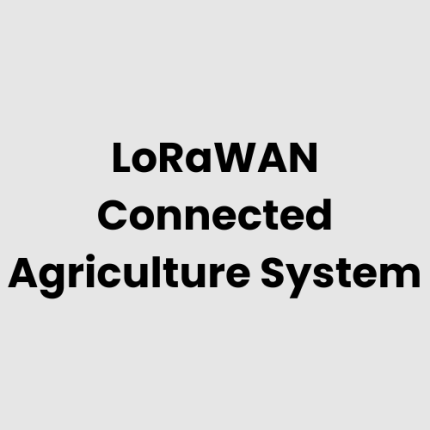Description
Technical Architecture of LoRaWAN Enabled Remote Sensing and Geographic Information System
The LoRaWAN Enabled Remote Sensing and Geographic Information System (GIS) is built upon a combination of IoT sensors, LoRaWAN gateways, cloud infrastructure, and geographic information platforms. Sensors deployed in the field collect environmental data such as temperature, humidity, atmospheric pressure, and air quality. This data is transmitted via LoRaWAN protocols to nearby gateways, which then relay it to a cloud server for processing and integration with GIS applications. The system combines real-time sensor data with spatial information to create actionable insights for users, supporting a variety of industries such as environmental monitoring, agriculture, and urban planning.
List of Hardware of LoRaWAN Enabled Remote Sensing and Geographic Information System
- LoRaWAN Sensors: To measure environmental variables like temperature, humidity, atmospheric pressure, air quality, and soil moisture.
- LoRaWAN Gateways: To receive data from sensors and forward it to the cloud or local server via LoRaWAN protocol.
- GPS Modules: To tag sensor data with geographic location information.
- Base Station: To handle the communication between the LoRaWAN sensors, gateways, and the network server.
- Power Supply Units: To power the sensors and gateways, often including solar or battery backup for remote locations.
- Computers/Servers: For data processing, storage, and running GIS software applications.
- Remote Terminals: For monitoring and controlling the system remotely.
Physical Placement Considerations of the Hardware of LoRaWAN Enabled Remote Sensing and Geographic Information System
- Sensor Placement: Sensors should be placed in areas where environmental data collection is critical, ensuring they are in positions that will accurately represent the target data. For example, temperature and humidity sensors should be installed in shaded areas to avoid heat distortion, and air quality sensors should be placed in areas with clear airflow.
- Gateway Placement: Gateways should be strategically positioned to ensure strong signal coverage, minimizing interference and optimizing data transfer from sensors to the cloud. This may include elevated positions, such as rooftops or tall structures, to cover larger areas.
- Power Supply Considerations: In remote or outdoor environments, renewable energy solutions like solar panels should be used to ensure continuous power supply to remote sensors and gateways.
- Communication Range: The placement of sensors and gateways should consider the LoRaWAN range to ensure that the entire sensor network is effectively covered without data loss.
Hardware Architecture of LoRaWAN Enabled Remote Sensing and Geographic Information System
The architecture of the LoRaWAN Enabled Remote Sensing and Geographic Information System consists of the following main components:
- Sensors: These gather data from the environment and are designed for different applications like weather monitoring, soil health, air quality, and more.
- LoRaWAN Gateway: LoRaWAN protocol enables long-range, low-power communication between the sensors and the cloud or local server.
- Network Server: Manages and routes the data between gateways, sensors, and applications. It also handles security and communication protocols.
- Cloud Infrastructure: A central platform to store, process, and analyze sensor data. GIS applications and databases are integrated here to provide spatial analysis.
- Geographic Information System (GIS): Visualizes and analyzes the sensor data with spatial context, offering features like mapping, geographic data analysis, and decision support tools.
Deployment Considerations of LoRaWAN Enabled Remote Sensing and Geographic Information System
- Location Assessment: Before deploying the system, a site survey should be conducted to understand environmental conditions and determine ideal sensor placement. In areas with difficult terrain or dense buildings, consideration for the placement of gateways is crucial to maximize coverage.
- Scalability: Ensure that the system is designed to accommodate the addition of new sensors and gateways as needed, allowing for future expansion of the monitoring system.
- Connectivity: In areas with limited network infrastructure, LoRaWAN provides an excellent solution for long-range communication without relying on cellular networks. However, ensuring stable gateway communication with cloud servers is vital for real-time data.
- System Maintenance: Regular maintenance should be planned to replace batteries or check sensor calibration to ensure the system remains operational over time.
List of Relevant Industry Standards and Regulations (Without Descriptions)
- LoRaWAN Specification (LoRa Alliance)
- ISO/IEC 27001:2013 (Information Security Management)
- GDPR (General Data Protection Regulation)
- FCC Part 15 (Wireless Communications)
- ITU-T G.993.2 (XDSL for Communication Networks)
- IEEE 802.15.4 (Low-Rate Wireless Personal Area Networks)
- Environmental Protection Agency (EPA) Regulations
- National Institute of Standards and Technology (NIST) Cybersecurity Framework
Local Server Version of LoRaWAN Enabled Remote Sensing and Geographic Information System
The LoRaWAN Enabled Remote Sensing and Geographic Information System can operate with a local server version where all data processing, storage, and GIS applications are handled within an organization’s premises. In this setup:
- Data from the sensors is sent directly to a locally installed server, reducing dependency on external cloud platforms.
- GIS mapping and analysis software are installed on local machines, allowing users to access data, perform analysis, and generate reports in real time.
- The local server provides enhanced security, as sensitive data remains within the organization’s firewall.
This setup is ideal for scenarios where data privacy or compliance regulations require data to be stored within specific geographical regions or when internet connectivity is unreliable.
Cloud Integration and Data Management
Cloud integration plays a key role in the LoRaWAN Enabled Remote Sensing and Geographic Information System, enabling seamless data management, storage, and analytics:
- Data Transmission: The sensors send data to the LoRaWAN gateways, which transmit it to a centralized cloud server for further processing.
- Data Storage: All incoming data is securely stored in cloud databases, offering scalable storage solutions.
- Data Processing: Cloud platforms provide powerful processing capabilities, including the integration of GIS mapping, data visualization, and real-time analysis.
- Data Accessibility: The cloud platform makes data available remotely, allowing users to access the information from anywhere through web-based interfaces or mobile apps.
- Integration with Other Systems: The system can be integrated with other IoT devices, third-party applications, and enterprise systems, providing comprehensive insights and decision-making support.
GAO Case Studies of LoRaWAN Enabled Remote Sensing and Geographic Information Systems
United States
- New York City, NY
A LoRaWAN-enabled remote sensing and GIS system was deployed to monitor air quality and pollution levels across multiple neighbourhoods. Real-time data collection, transmitted to cloud platforms, helped the city’s environmental departments to respond to pollution spikes effectively, ensuring public health safety and compliance with environmental regulations.
- Los Angeles, CA
In Los Angeles, the system was implemented to monitor urban temperature variations and water usage. GIS integration provided detailed insights into heat islands, and sensor data allowed for more efficient management of water resources, enhancing the city’s sustainability efforts.
- Chicago, IL
The city of Chicago integrated a LoRaWAN remote sensing system to monitor weather conditions and environmental parameters such as temperature and wind speed. Data was used to optimize emergency response strategies, helping the city prepare for extreme weather events and enhance its resilience to climate change.
- Houston, TX
Houston deployed LoRaWAN-based air quality sensors across industrial zones to monitor emissions and pollutants. The system provided real-time data to local authorities, improving the city’s regulatory enforcement and ensuring compliance with state and federal environmental standards.
- Phoenix, AZ
LoRaWAN sensors installed in Phoenix helped monitor soil moisture levels in agricultural areas. The system provided real-time data to farmers, enabling them to optimize irrigation schedules and improve water conservation in the region, essential in the water-scarce Southwest.
- San Francisco, CA
A LoRaWAN-enabled GIS system in San Francisco provided comprehensive monitoring of urban green spaces. It integrated environmental data such as air quality and temperature with GIS, helping local authorities track the impact of greenery on urban heat island effects and public health.
- Atlanta, GA
In Atlanta, LoRaWAN sensors were deployed to monitor water quality and rainfall data in local rivers and lakes. This data, integrated with GIS, allowed environmental agencies to track water pollution and develop strategies to maintain the region’s water safety and ecosystem health.
- Dallas, TX
LoRaWAN remote sensing technology was applied to monitor atmospheric conditions around Dallas. Data from sensors was transmitted via LoRaWAN and analyzed to predict extreme weather patterns, helping local authorities prepare for severe events such as tornadoes or thunderstorms.
- Miami, FL
Miami implemented a remote sensing system to track sea-level rise and coastal erosion using LoRaWAN sensors placed along beaches and shorelines. Real-time data supported GIS analysis, providing actionable insights into coastal management and climate change adaptation strategies.
- Seattle, WA
Seattle used LoRaWAN-enabled environmental sensors to track air and water quality, especially in industrial areas and urban centers. The system, combined with GIS, allowed environmental agencies to detect pollutants in real time and issue alerts to the public or regulate industrial emissions.
- Boston, MA
In Boston, LoRaWAN-enabled sensors were deployed to track urban heat islands, which are areas that experience significantly higher temperatures than their surroundings. Data was integrated with GIS to provide visual insights into how green spaces can mitigate these temperature variations.
- Denver, CO
LoRaWAN technology was used to create a comprehensive environmental monitoring system in Denver. The system provided data on air quality, soil moisture, and weather conditions, which was integrated into GIS platforms for better urban planning and resource management.
- Washington, D.C.
The nation’s capital used LoRaWAN remote sensing and GIS to monitor the city’s environmental health. The system helped manage air quality, water resources, and environmental compliance with government regulations, ensuring the city remains a model of urban sustainability.
- Orlando, FL
In Orlando, LoRaWAN sensors were deployed across tourist areas and parks to monitor air quality and other environmental factors. Data collected was fed into GIS software to provide real-time reports on environmental health, helping the city manage tourism and local ecology.
- Salt Lake City, UT
Salt Lake City applied LoRaWAN technology to monitor environmental conditions in mountainous areas surrounding the city. With LoRaWAN sensors tracking temperature, humidity, and snowpack levels, the system supported better water resource management and flood prevention strategies.
Canada
- Toronto, ON
In Toronto, a LoRaWAN-enabled system was implemented to monitor environmental factors in urban green spaces. The system combined real-time sensor data with GIS to provide insights into how parks affect local climate conditions, helping with urban planning and sustainability initiatives. - Vancouver, BC
Vancouver deployed a LoRaWAN-based remote sensing system to track air pollution levels in residential and industrial zones. The data collected through the system was integrated with GIS to optimize urban planning, ensuring that environmental standards were met and improving the quality of life for its residents.
Navigation Menu for LoRaWAN
Navigation Menu for IoT
- LORAWAN
- ZIGBEE
- Wi-Fi HaLow
- Z-WAVE
- BLE & RFID
- NB-IOT
- CELLULAR IOT
- GPS IOT
- IOT SENSORS
- EDGE COMPUTING
- IOT SYSTEMS
Our products are in stock and can be shipped anywhere in the continental U.S. or Canada from our local warehouse. For any further information, please fill out this form or email us.
We are actively looking for partners who are like us located in the U.S. and Canada. For more information on partnering with GAO, please visit Partner with GAO Tek Inc. It lists various ways to partner with GAO, such as OEM Partnerships, Technology Integration, Distribution and Reselling Opportunities, Presenting at the Leading Event Tek Summit, Joint R&D Projects, Training and Consulting Services, Industry-Specific Collaborations, Research and Academic Partnerships.



